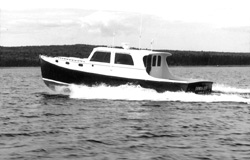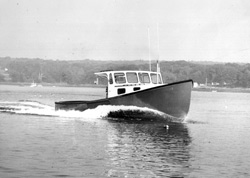
42' Custom built Duffy & Duffy, late 1980’s. Adding 8 to 10,000 lb. cabins, refrigerators, TVs and hot tubs to build a pleasure boat built on a lobster boat hull presents a few problems. To make the hull work well for both, Spencer Lincoln made them flatter with less angle of trim. |
“Lincoln has designed plenty of boats over the last 30 or so years. He is a designer, but recognizes the importance of a more hands-on approach to designing boats. Though probably best known for his lobster boats, he has designed everything from yachts and passenger ferries.
A Cape Neddick, Maine native, Lincoln started working on boat designs at Brewer & Walstrom & Associates in Brooklin, Maine. When Ted Brewer left the business for the west coast in 1976, Spencer, a draftsman at the time, suddenly found himself designing lobster boats on his own.
Spencer started professionally designing boats at a time of significant change in boat building history. Before the mid 1970’s, lobster boats were built of wood, one small part at a time. When fiberglass burst onto the scene in the mid 70’s, the hull was built as a one-piece unit. However, fiberglass presented its own set of building and design problems, builders in Maine approached it differently.
At Webber’s Cove in the early 70’s, they used a round bottom Navy launch and adapted it for a lobster boat mold. Bruno and Stillman at that time had Royal Lowell design a glass lobster boat for them. But it was designed for the low powered traditional engine. Jarvis and Newman in Southwest Harbor used good, proven wood boats to build molds for their glass hulls. What these builders were doing characterizes the lobster boat building industry’s effort to adapt the new material to an old process.
With declining weight and rising horsepower, it didn’t require a psychic to predict the outcome. The prospects and potential of this combination got a few builders interested.
One of them was Richard Duffy, who, in 1975, owned a Newman 36. Duffy had to add 1,500 lbs. of concrete to bring her to her lines. Around this period Duffy decided he wanted to start building lobster boats and designed a 34-footer on the kitchen floor of his house in South Blue Hill with his father Rile. Spencer recalled Duffy being “frustrated by the difficulty of getting his vision into a set of plans to build molds and build the boat.”
It was in this atmosphere of experimentation that Lincoln began designing.
“Speed was a part of the design and building process. At the time the theory of what made a lobster boat fast was to get the tail down for minimum wetted surface. That was the theory behind the Duffy 34,” recalled Lincoln. However, some of these boats became unstable at speed. Lincoln started working with Duffy in 1978.

Duffy 35 at Stonington. Spencer Lincoln’s design changes to the bottom of the hull enabled the bow to lift sooner, with less effort and transfer effort to forward motion. |
vFiberglass didn’t just appear as a quick and simpler means of building a faster, cheaper boat that didn’t need paint. That was just the concept. In reality there was something else going on in the combination of the new material, hull design, speed and big engines. But what that was, was not exactly clear.
Lincoln said, “New York and New Jersey were ahead of us by about twenty years with pleasure boat designs back then. They removed the keel, but went too far with the planning hull. Lobster boats were slower, but better sea boats.”
Lincoln thinks lobster boats are too deep. The keels trip up at higher speeds as the yaw angle increases in turns. There may be 31/2 to 4 feet of keel vertically in the water on a skeg built boat. In a turn at speed it becomes a wall pushing against the water, while the topside momentum is moving through thin air.
“The process of designing and building [these new boats] involved many pushes and pulls to make them work,” said Lincoln.
Changes to one area meant changes required in another area, which could affect a third, and so on. What amounted to the redesigning of the bottom of the lobster boat to take advantage of higher HP wasn’t done on a single hull, but on many hulls over a single decade. Spencer recalled some of the components and hull features that were changed in the early 1980’s.
Spencer used a Blue Hill Marine 31, with a built down hull, to build a boat with the motor under the floor behind the bulkhead for more space on deck. In figuring this out he said he “discovered the hull shape for the Duffy 35.” He recognized that the skeg built hull, with a flatter bottom aft and a vertical skeg or keel, should be faster than the built down hull, with a bottom that forms a reverse curve, “wine glass” shape in cross section. But, he said, “if done carefully enough, water got to the wheel,” in the built down hull to generate enough thrust.
“I had to get the center of buoyancy far enough forward to support the engine low in the hull, which meant I needed volume forward,” he said.
He was finding that speed was not coming from dropping the tail down, but getting the hull up on the water. To do it, the different components of what makes a boat go had to be reconfigured and that was combined with differently drawn hull lines.
“This evolved over a period of years,” Lincoln said, “and culminated in the Duffy 35.”
Builders in the past carved changes in design into a half model from which they took lines. Now, the desired shape changes are drawn into the hull.
Among the other changes that contributed to the contemporary lobster boat coming into its own (and culminating in the Duffy 35) was flattening the buttock line. This was the shape that traditionally bulged out from the centerline of the hull amidship. It was most prominent in the sailing lobster sloop and was carried over some in the wood lobster boat through the 1960’s.

A Spencer Lincoln designed Duffy 35 peeling a clean slice of water off the surface. Early 1980’s. Photo: Red Boutilier |
Flattening the buttock line—making the sides of the hull straighter—let it the boat go through the water easier at higher speeds under power.
Another design shift that harked back to the problems facing the fishermen who first put engines in sloop boats, were those related to the angle of thrust. With the first engines in sloop boats, the steep angle of the shaft, combined with the narrow built down hull shape, nearly dragged the stern under.
Spencer changed the angle of the shaft to be closer to the flow of water under the hull, and thus reduced the force required to raise the bow. Increasing the pressure on the planning surface meant it took less effort to raise the bow. The effort reduction could therefore be used in forward motion.
More rounded buttock lines results in easier cruising at 15 - 16 knots. But Lincoln said he “employs a straighter buttock line for a higher potential top speed at about 20 knots. It also allows for carrying more weight at those speeds.”
What works well for a lobster boat design isn’t the same for a pleasure boat that is built off the same mold. The difference is in the weight. A 35’ Duffy and Duffy work boat may be 12,000 lbs. But the same boat built as a pleasure boat may be 20,000 lbs. after the cabin, freezer, 400hp engine, larger fuel capacity, bridge, ice makers and TVs, etc., are built in. Spencer’s solution for making a hull work well for both was to make them flatter, with less angle of trim.
Lincoln says he loved designing boats, and that he sometimes can’t believe he earned a living doing what likes so.
One of the benefits of fiberglass for designers came from production boats. Fiberglass construction is well suited to production; While the fees are lower for them individually, but many can be produced from a single design and royalties make up the difference.
Spencer Lincoln says of his years designing boats, “It was fun - some great people to work with - Richard, Tim, Bruce, Larry, Moe, and Curly.” These days, however, he looks forward to surfing and motorcycling, preferably in a warmer climate.
|





